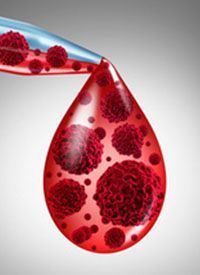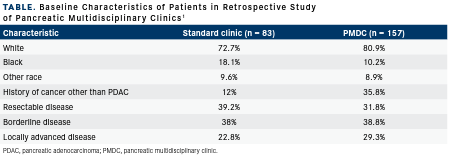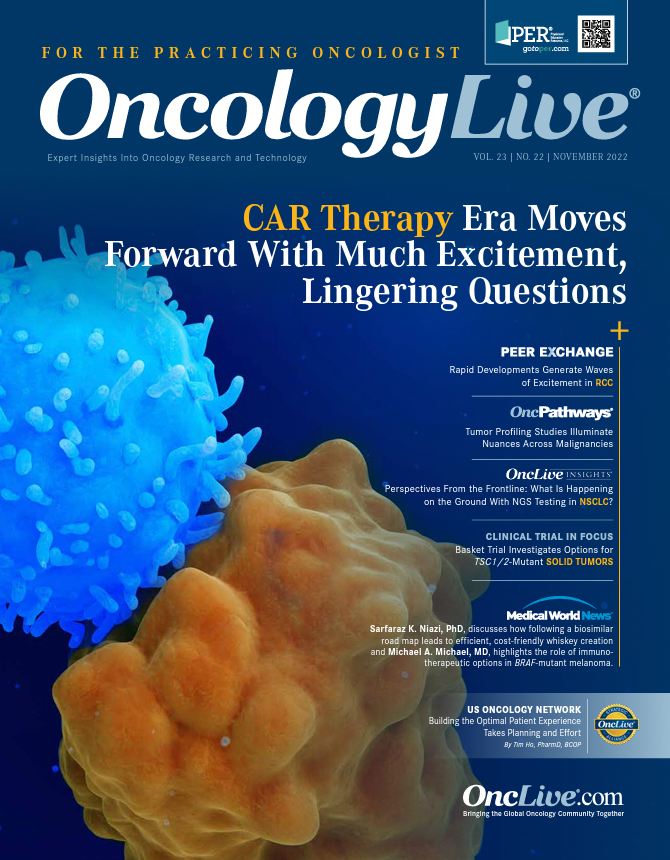Multidisciplinary Approach Leads to Higher Rate of Neoadjuvant Treatment Completion in Pancreatic Cancer
Patients with localized pancreatic adenocarcinoma who received care at a multidisciplinary clinic had significantly higher neoadjuvant therapy completion rates than those treated at a specialty-specific clinic.

Patients with localized pancreatic adenocarcinoma who received care at a multidisciplinary clinic had significantly higher neoadjuvant therapy completion rates than those treated at a specialty-specific clinic, according to findings from a retrospective study presented at the 2022 Quality Care Symposium of the American Society of Clinical Oncology.1
Patients whose treatment was coordinated through a multidisciplinary clinic (n = 157) completed their neoadjuvant treatment regimen per institutional standards at a rate of 71%, whereas the 83 treated at an individual clinic (surgical, medical, or radiation oncology) did so at a rate of 46.1% (P = .002). In addition, the rate of clinical trial enrollment was greater among the former (16.6%) than the latter (7.2%) (P = .043).1
The adjusted odds ratio (aOR) for completion of neoadjuvant therapy per institutional standards for patients seen via multidisciplinary clinics vs standard oncology clinics was 3.35 (95% CI, 1.46-7.07; P =.004). In terms of clinical trial enrollment, the aOR in the multidisciplinary clinic cohort was 2.44 (95% CI, 0.94-6.35; P =.067).1
Investigators used data from the Institutional Pancreatic Cancer Registry to compile a study population made up of patients who received a diagnosis of localized pancreatic adenocarcinoma between 2018 and 2020 at Johns Hopkins Hospital in Baltimore, Maryland. To be eligible for the study, patients needed to have disease for which resection was eventually undertaken and to have come to Johns Hopkins either via its pancreatic multidisciplinary clinic or through one of its surgical, medical, or radiation oncology clinics.
TABLE. Baseline Characteristics of Patients in Retrospective Study of Pancreatic Multidisciplinary Clinics

The primary outcome of the study was the completion of neoadjuvant therapy as per stage-specific institutional standards. Clinical trial enrollment included only patients who had been admitted to an institutional clinical trial. Investigators noted that during the study period, it had been standard practice for patients with borderline resectable disease to be treated with neoadjuvant chemotherapy for a minimum of 4 months, with or without preoperative radiation, before transitioning to exploration. Patients with locally advanced disease received 4 to 6 months of chemotherapy, then radiation, followed by potential exploration.
Baseline patient characteristics were well-balanced between cohorts, with a median age of 67 years for both those treated at standard clinics (range, 58-73 years) and at multidisciplinary clinics (range, 61-73 years). Patients had a history of other cancers at a rate of 12% and 35.8%, respectively. Most patients in both arms had an ECOG performance status of 1 or less (63.9% vs 91.7%, respectively).
Additional findings showed that patients who came to Johns Hopkins via a multidisciplinary clinic experienced a survival benefit. Death rates were 28.7% in the standard clinic and 20.5% in the multidisciplinary clinic (P =.157).
More multidisciplinary clinic patients than standard clinic patients had neoadjuvant radiation therapy (59.7% vs 34.9%; P =.004). Patients in the standard clinic arm had a slightly lower rate of recurrence (38.5%) than those in the multidisciplinary clinic arm (40.1%; P = .421).
The median number of visits to the pancreatic multidisciplinary clinic was 1 (range, 1-6) and the authors noted that multiple visits to the clinic were not associated with the completion of neoadjuvant therapy.
Following the outline set by the pancreatic multidisciplinary clinic at Johns Hopkins’ Skip Viragh Center for Pancreatic Cancer, the aim of the team should combine insights from medical and radiation oncologists, surgeons, radiologists, pathologists, and other clinicians to provide a complete comprehensive examination. The multidisciplinary clinic is also able to diagnose, educate, and create personalized treatment plans for patients.2
Patients should meet with specialty clinicians based on their specific needs and then have their cases reviewed by an expert panel. The multidisciplinary clinic is best suited for patients with newly diagnosed disease that is treatment-naïve, those with locally advanced disease that is unresectable or borderline resectable, and those who have undergone surgery for pancreatic cancer but have not started chemotherapy and/or radiation therapy.




